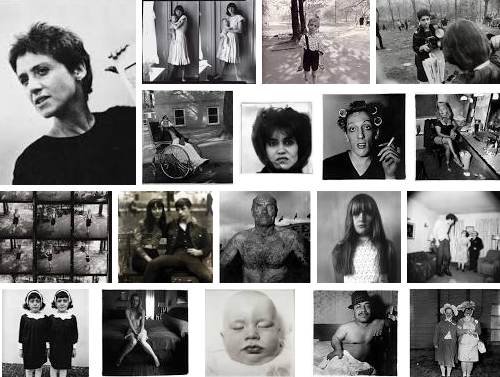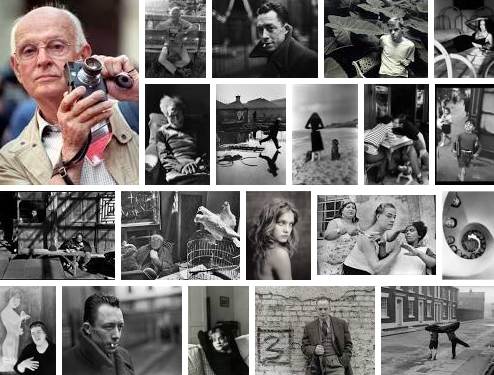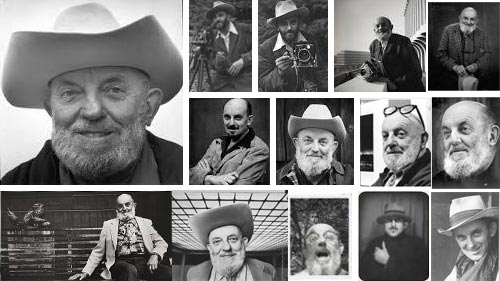
Photomontage of Diane Arbus and some of her work.
“My favorite thing is to go where I’ve never been.” • Diane Arbus
Click to view a range of her work and portraits of her in Google Images.
Swim against the tide!
Your personal mission in life is important and your photography should reflect that. Don’t only transmit passion through your work. Diane Arbus worked in photography but found a rarely paralleled depth of expression in her exploration of a personal passion. She persevered even when that passion took her into domains that the public would rather have left unseen at the time.
Diane Arbus (Mar 14, 1923 – Jul 26, 1971)
The creation of a picture lies within the ability of everyone who holds a camera. Conjuring a meaningful ‘image’ in the mind and creating an enduring memory for the viewer takes a photographer with passion and expression far beyond simple picture taking. Diane Arbus was a phenomenon and a case in point. Throughout her varied career she was able to express her interests in ways that shocked or left people cold.
Born to a wealthy, talented and artistic family Diane Nemerov escaped the worst of the American Depression. Her siblings excelled in art and photography as did her father who retired from the family business to paint. She married at eighteen to Allan Arbus. Both interested in photography, they began a business after WWII in commercial and advertising photography. They were published in a wide range of well known magazines of the time, despite professing their hate of the fashion world.
During the late 1940’s and 1950s the Arbus’ raised two daughters. The couple separated in 1958 and divorced 11 years later. It was the late 1950s and 1960s that saw her unique style coming out. Working with a wider range of client publications she extended her personal ideas and techniques through assignment work. In 1963 she was awarded a Guggenheim Fellowship for a project called “American rites, manners, and customs”. This allowed her to extend her interests and to develop her personal style. While teaching, working on her projects and doing some assignment work the 1960s were a proving ground for her approach. Her commercial work declined as she became better known as an artist.
What made Diane Arbus unique was an exploration of her real interest. She pursued her photography working with “deviant and marginal people”. Her passionate portrayal of dwarfs, giants, transgender people, nudists, circus performers and other “ugly or surreal” people was for the time pretty brave and definitely against the grain of public opinion. Her work in advertising is little known today. Her writing and photographs of people at the margins of society bought her condemnation and severe criticism. Some of her work is still considered to be controversial. Yet, despite open criticism and damaging condemnation of her and her work she stuck to her interests and passionately expressed herself.
Her images are stark and sometimes ugly. However, this was the way she portrayed the world and was consistent in that approach. The extent to which she was a tortured individual is not clear, but she suffered bouts of depression and committed suicide aged 48 in 1971. Her legacy lies in her extraordinary persistence working with people considered to be ‘freaks’ in her contemporary America. She was notable in her success in getting permission from her subjects to publish the photographs. She established close personal relationships with many of her subjects while also portraying their less than ideal circumstances. And, she often returned over many years to take more photographs. Some of her images are shocking and harsh. Yet she seemed intent on hard lines, hard light and portraying people who had hard lives.
She produced a range of iconic images of people in difficult circumstances, against the public wisdom of the time. Diane Arbus remains controversial. But she published both photographs and writings that showed how she understood the nature of her own work and the impact it was having. She is one of my heroes because she stood up for herself and did photography with a passion. She showed important issues for what they were and exposed the underbelly of American culture at that time. Her work is sought-after as collectors items. Auction sales of individual pictures in the last decade have exceeded several hundred thousand dollars. Yet this has not diminished her insight. Important and controversial she may have been, but a powerful photographer with a passionate message she remains today.
Two quotes by Arbus define for me her outlook on her photography…
“Freaks was a thing I photographed a lot . . . . Most people go through life dreading they’ll have a traumatic experience. Freaks were born with their trauma. They’ve already passed their test in life. They’re aristocrats.”
Arbus, Diane. “Diane Arbus”. Millerton, New York: Aperture, 1972. ISBN 0-912334-40-1.
In this quote you can see the passion spilling out of her words…
I do feel I have some slight corner on something about the quality of things. I mean it’s very subtle and a little embarrassing to me, but I really believe there are things which nobody would see unless I photographed them.
Feeney, Mark. “She Opened Our Eyes. Photographer Diane Arbus Presented a New Way of Seeing.” Boston Globe, November 2, 2003.
In my twitter stream (@photokonnexion) I push photographers to ‘do their own thing’ with a passion borne of insight from a personal mission in life. Many contemporary professional photographers fall onto the media bandwagon and get trapped in a cycle of commercial and media ‘art’. As a result they never see their personal development get past commercialism. I would encourage photographers of all types to look for ways to make their own mark in photography. As artists, photographers should be looking to expand their own horizons. I urge you to explore new challenges that define you as a photographer. Diane Arbus was not afraid to go down this route, neither should you.
The following video is the first of four. See all four parts of this video here: Masters of Photography Diane Arbus (Parts 1 to 4)
[youtube http://www.youtube.com/watch?v=wKXwCctBLQU&w=500&h=375]
Masters of Photography Diane Arbus Part 1. By Rangefinder 
By Damon Guy (author and Photokonnexion editor)

Damon Guy (Netkonnexion)
Damon is a writer-photog and editor of this site. He has run some major websites, a computing department and a digital image library. He started out as a trained teacher and now runs training for digital photographers.
See also:
Editors ‘Bio’.
 Get Photokonnexion tips by email!
Get Photokonnexion tips by email!






